CS50: Week 4 - Memory
- Welcome!
- Keyword
- Pixel Art
- Hexadecimal
- Memory
- Pointers
- Strings
- Pointer Arithmetic
- String Comparison
- Copying
- malloc and Valgrind
- Garbage Values
- Pointer Fun with Binky
- Swap
- Overflow
scanf- File I/O
- Summing Up
Welcome!
- In previous weeks, we talked about images being made of smaller building blocks called pixels.
- Today, we will go into further detail about the zeros and ones that make up these images. In particular, we will be going deeper into the fundamental building blocks that make up files, including images.
- Further, we will discuss how to access the underlying data stored in computer memory.
Keyword
Memory Management
- Pointers: Variables that store memory addresses.
- Segmentation Faults: Errors caused by invalid memory access.
- Dynamic Memory Allocation: Allocating memory at runtime.
- Stack: A data structure for storing function calls and local variables.
- Heap: A region of memory for dynamic memory allocation.
- Buffer Overflow: An error where data overruns the allocated memory space.
Input/Output
- File I/O: Input and output operations involving files.
Data Representation
- Images: Digital representations of visual information.
Pixel Art
- Pixels are squares, individual dots, of color that are arranged on an up-down, left-right grid.
- You can imagine as an image as a map of bits, where zeros represent black and ones represent white.
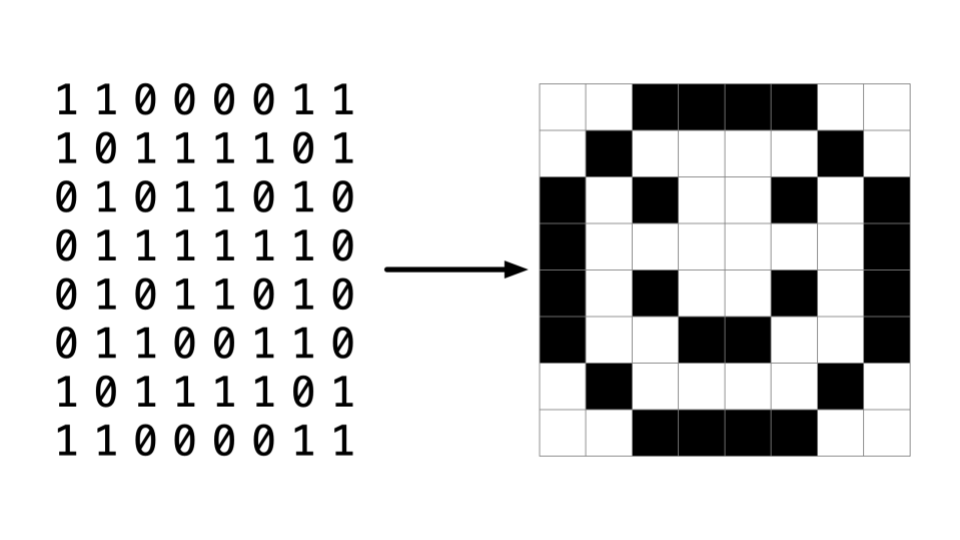
- RGB, or red, green, blue, are numbers that represent the amount of each of these colors. In Adobe Photoshop, you can see these settings as follows:
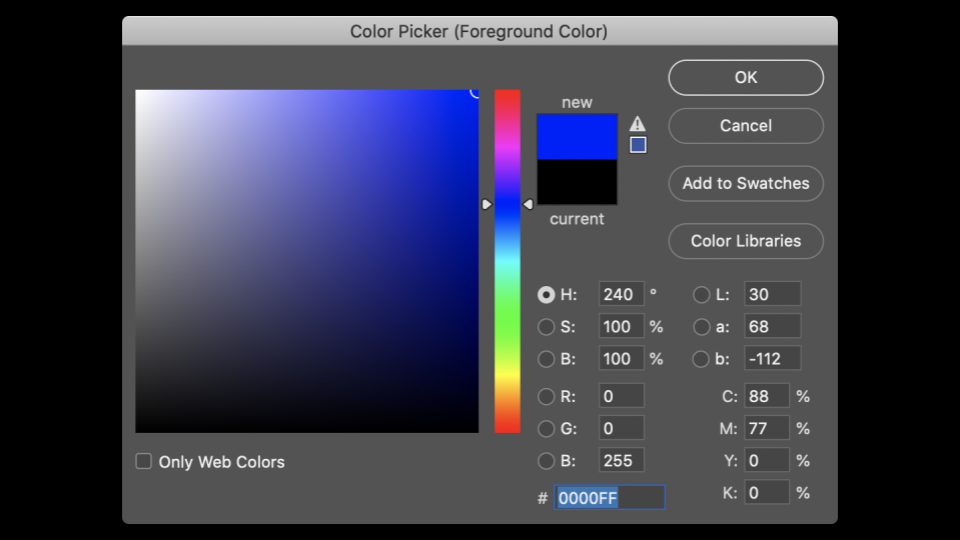
Notice how the amount of red, blue, and green changes the color selected.
- You can see by the image above that color is not just represented in three values. At the bottom of the window, there is a special value made up of numbers and characters.
255is represented asFF. Why might this be?
Hexadecimal
- Hexadecimal is a system of counting that has 16 counting values. They are as follows:
0 1 2 3 4 5 6 7 8 9 a b c d e f
Notice that F represents 15.
- Hexadecimal is also known as base-16.
- When counting in hexadecimal, each column is a power of 16.
- The number
0is represented as00. - The number
1is represented as01. - The number
9is represented by09. - The number
10is represented as0A. - The number
15is represented as0F. - The number
16is represented as10. - The number
255is represented asFF, because 16 x 15 (orF) is 240. Add 15 more to make 255. This is the highest number you can count using a two-digit hexadecimal system. - Hexadecimal is useful because it can be represented using fewer digits. Hexadecimal allows us to represent information more succinctly.
Memory
- In weeks past, you may recall our artist rendering of concurrent blocks of memory. Applying hexadecimal numbering to each of these blocks of memory, you can visualize these as follows:
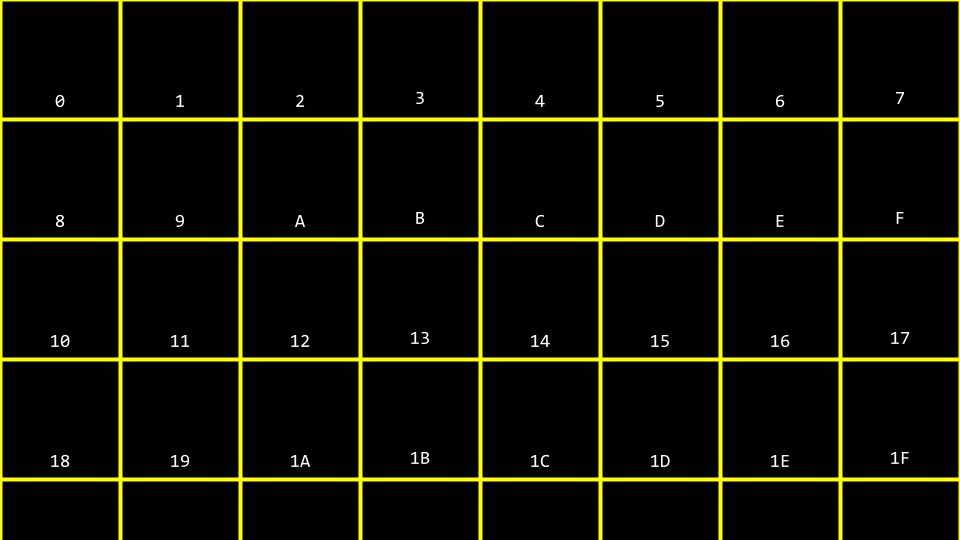
- You can imagine how there may be confusion regarding whether the
10block above may represent a location in memory or the value10. Accordingly, by convention, all hexadecimal numbers are often represented with the0xprefix as follows:
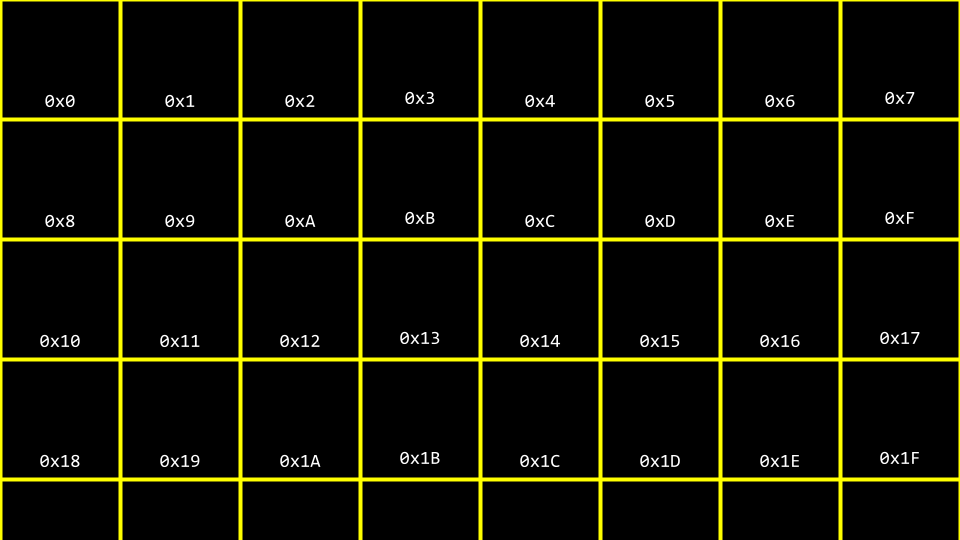
- In your terminal window, type
code addresses.cand write your code as follows:
#include <stdio.h>
int main(void)
{
int n = 50;
printf("%i\n", n);
}
Notice how n is stored in memory with the value 50.
- You can visualize how this program stores this value as follows:
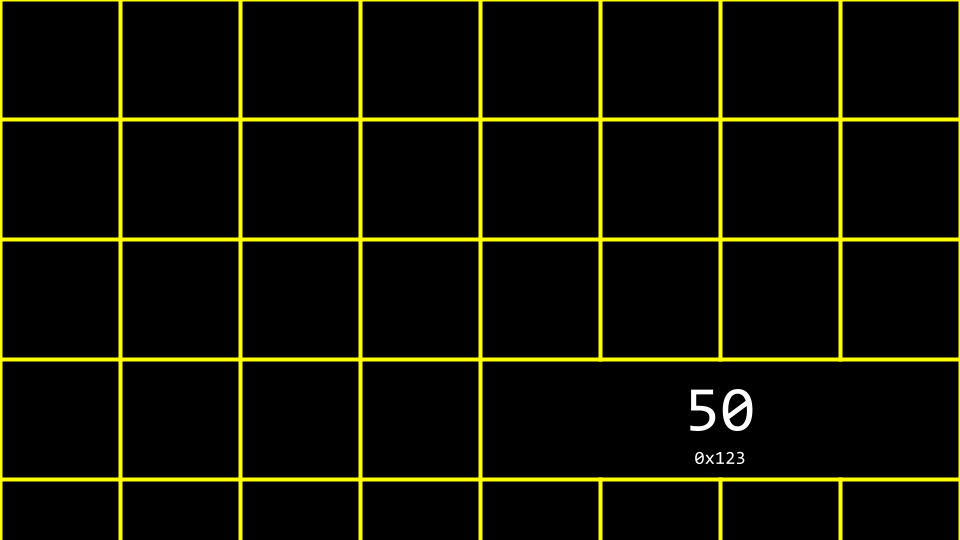
- The
Clanguage has two powerful operators that relate to memory:
& Provides the address of something stored in memory.
* Instructs the compiler to go to a location in memory.
- We can leverage this knowledge by modifying our code as follows:
#include <stdio.h>
int main(void)
{
int n = 50;
printf("%p\n", &n);
}
Notice the %p, which allows us to view the address of a location in memory. &n can be literally translated as “the address of n.” Executing this code will return an address of memory beginning with 0x.
Pointers
- A pointer is a variable that contains the address of some value. Most succinctly, a pointer is an address in your computer’s memory.
- Consider the following code:
Notice that p is a pointer that contains the address of an integer n.
- Modify your code as follows:
#include <stdio.h>
int main(void)
{
int n = 50;
int *p = &n;
printf("%p\n", p);
}
Notice that this code has the same effect as our previous code. We have simply leveraged our new knowledge of the & and * operators.
- To illustrate the use of the
*operator, consider the following:
#include <stdio.h>
int main(void)
{
int n = 50;
int *p = &n;
printf("%i\n", *p);
}
Notice that the printf line prints the integer at the location of p. int *p creates a pointer whose job is to store the memory address of an integer.
- You can visualize our code as follows:
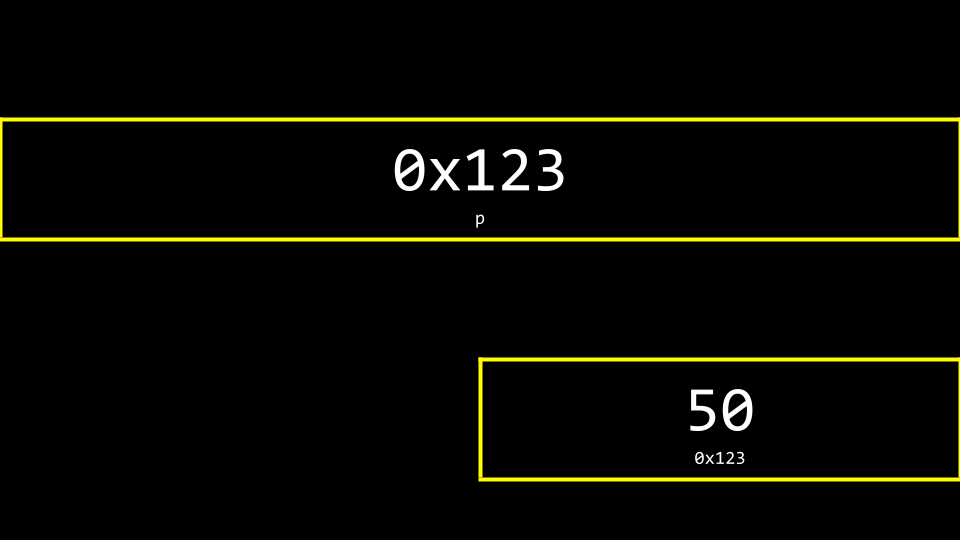
Notice the pointer seems rather large. Indeed, a pointer is usually stored as an 8-byte value. p is storing the address of the 50.
- You can more accurately visualize a pointer as one address that points to another:
Strings
- Now that we have a mental model for pointers, we can peel back a level of simplification that was offered earlier in this course.
- Recall that a string is simply an array of characters. For example,
string s = "HI!"can be represented as follows:
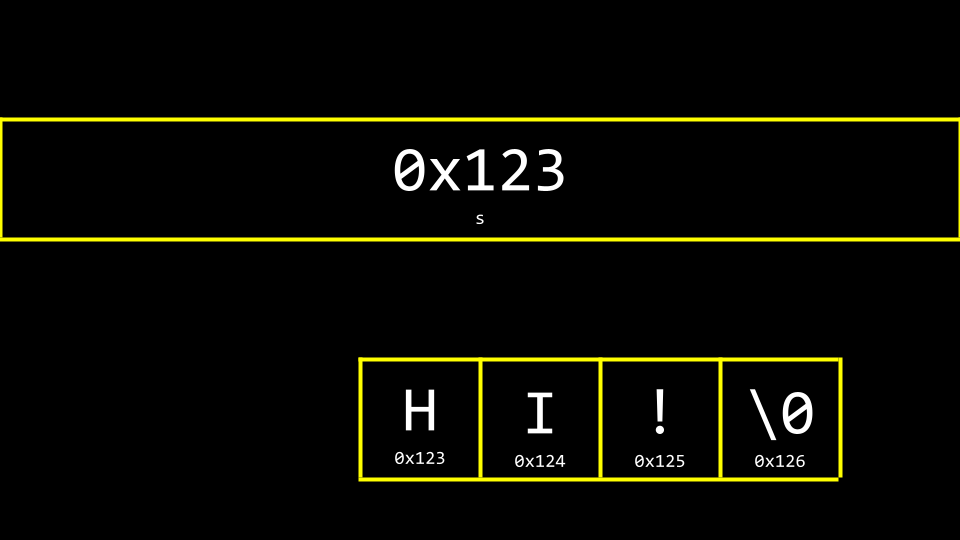
- However, what is
sreally? Where is thesstored in memory? As you can imagine,sneeds to be stored somewhere. You can visualize the relationship ofsto the string as follows:
Notice how a pointer called s tells the compiler where the first byte of the string exists in memory.
- Modify your code as follows:
#include <cs50.h>
#include <stdio.h>
int main(void)
{
string s = "HI!";
printf("%p\n", s);
printf("%p\n", &s[0]);
printf("%p\n", &s[1]);
printf("%p\n", &s[2]);
printf("%p\n", &s[3]);
}
Notice the above prints the memory locations of each character in the string s. The & symbol is used to show the address of each element of the string. When running this code, notice that elements 0, 1, 2, and 3 are next to one another in memory.
- Likewise, you can modify your code as follows:
#include <stdio.h>
int main(void)
{
char *s = "HI!";
printf("%s\n", s);
}
Notice that this code will present the string that starts at the location of s. This code effectively removes the training wheels of the string data type offered by cs50.h. This is raw C code, without the scaffolding of the cs50 library.
- You can imagine how a string, as a data type, is created.
- Last week, we learned how to create your own data type as a struct.
- The cs50 library includes a struct as follows:
typedef char *string - This struct, when using the cs50 library, allows one to use a custom data type called
string.
Pointer Arithmetic
- You can modify your code to accomplish the same thing in a longer form as follows:
#include <stdio.h>
int main(void)
{
char *s = "HI!";
printf("%c\n", s[0]);
printf("%c\n", s[1]);
printf("%c\n", s[2]);
}
Notice that we are printing each character at the location of s.
- Further, you can modify your code as follows:
#include <stdio.h>
int main(void)
{
char *s = "HI!";
printf("%c\n", *s);
printf("%c\n", *(s + 1));
printf("%c\n", *(s + 2));
}
Notice that the first character at the location of s is printed. Then, the character at the location s + 1 is printed, and so on.
String Comparison
- A string of characters is simply an array of characters identified by its first byte.
- Earlier in the course, we considered the comparison of integers. We could represent this in code by typing
code compare.cinto the terminal window and writing code as follows:
#include <cs50.h>
#include <stdio.h>
int main(void)
{
// Get two integers
int i = get_int("i: ");
int j = get_int("j: ");
// Compare integers
if (i == j)
{
printf("Same\n");
}
else
{
printf("Different\n");
}
}
Notice that this code takes two integers from the user and compares them.
- In the case of strings, however, one cannot compare two strings using the
==operator. - Utilizing the
==operator in an attempt to compare strings will attempt to compare the memory locations of the strings instead of the characters therein. Accordingly, we recommended the use ofstrcmp. - To illustrate this, modify your code as follows:
#include <cs50.h>
#include <stdio.h>
int main(void)
{
// Get two strings
char *s = get_string("s: ");
char *t = get_string("t: ");
// Compare strings' addresses
if (s == t)
{
printf("Same\n");
}
else
{
printf("Different\n");
}
}
Noticing that typing in HI! for both strings still results in the output of Different.
- Why are these strings seemingly different? You can use the following to visualize why:
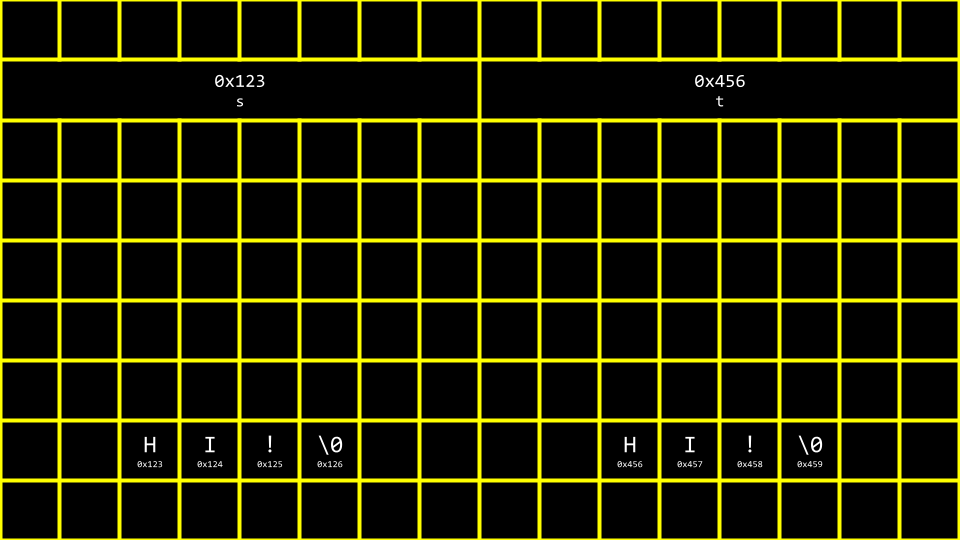
- Therefore, the code for
compare.cabove is actually attempting to see if the memory addresses are different: not the strings themselves. - Using
strcmp, we can correct our code:
#include <cs50.h>
#include <stdio.h>
#include <string.h>
int main(void)
{
// Get two strings
char *s = get_string("s: ");
char *t = get_string("t: ");
// Compare strings
if (strcmp(s, t) == 0)
{
printf("Same\n");
}
else
{
printf("Different\n");
}
}
Notice that strcmp can return 0 if the strings are the same.
- To further illustrate how these two strings are living in two locations, modify your code as follows:
#include <cs50.h>
#include <stdio.h>
int main(void)
{
// Get two strings
char *s = get_string("s: ");
char *t = get_string("t: ");
// Print strings
printf("%s\n", s);
printf("%s\n", t);
}
Notice how we now have two separate strings stored likely at two separate locations.
- You can see the locations of these two stored strings with a small modification:
#include <cs50.h>
#include <stdio.h>
int main(void)
{
// Get two strings
char *s = get_string("s: ");
char *t = get_string("t: ");
// Print strings' addresses
printf("%p\n", s);
printf("%p\n", t);
}
Notice that the %s has been changed to %p in the print statement.
Copying
- A common need in programming is to copy one string to another.
- In your terminal window, type
code copy.cand write code as follows:
#include <cs50.h>
#include <ctype.h>
#include <stdio.h>
#include <string.h>
int main(void)
{
// Get a string
string s = get_string("s: ");
// Copy string's address
string t = s;
// Capitalize first letter in string
t[0] = toupper(t[0]);
// Print string twice
printf("s: %s\n", s);
printf("t: %s\n", t);
}
Notice that string t = s copies the address of s to t. This does not accomplish what we are desiring. The string is not copied – only the address is.
- You can visualize the above code as follows:

Notice that s and t are still pointing at the same blocks of memory. This is not an authentic copy of a string. Instead, these are two pointers pointing at the same string.
- Before we address this challenge, it’s important to ensure that we don’t experience a segmentation fault through our code, where we attempt to copy
string stostring t, wherestring tdoes not exist. We can employ thestrlenfunction as follows to assist with that:
#include <cs50.h>
#include <ctype.h>
#include <stdio.h>
#include <string.h>
int main(void)
{
// Get a string
string s = get_string("s: ");
// Copy string's address
string t = s;
// Capitalize first letter in string
if (strlen(t) > 0)
{
t[0] = toupper(t[0]);
}
// Print string twice
printf("s: %s\n", s);
printf("t: %s\n", t);
}
Notice that strlen is used to make sure string t exists. If it does not, nothing will be copied.
-
To be able to make an authentic copy of the string, we will need to introduce two new building blocks. First,
mallocallows you, the programmer, to allocate a block of a specific size of memory. Second,freeallows you to tell the compiler to free up that block of memory you previously allocated. -
We can modify our code to create an authentic copy of our string as follows:
#include <cs50.h>
#include <ctype.h>
#include <stdio.h>
#include <stdlib.h>
#include <string.h>
int main(void)
{
// Get a string
char *s = get_string("s: ");
// Allocate memory for another string
char *t = malloc(strlen(s) + 1);
// Copy string into memory, including '\0'
for (int i = 0; i <= strlen(s); i++)
{
t[i] = s[i];
}
// Capitalize copy
t[0] = toupper(t[0]);
// Print strings
printf("s: %s\n", s);
printf("t: %s\n", t);
}
Notice that malloc(strlen(s) + 1) creates a block of memory that is the length of the string s plus one. This allows for the inclusion of the null \0 character in our final, copied string. Then, the for loop walks through the string s and assigns each value to that same location on the string t.
- It turns out that there is an inefficiency in our code. Modify your code as follows:
#include <cs50.h>
#include <ctype.h>
#include <stdio.h>
#include <stdlib.h>
#include <string.h>
int main(void)
{
// Get a string
char *s = get_string("s: ");
// Allocate memory for another string
char *t = malloc(strlen(s) + 1);
// Copy string into memory, including '\0'
for (int i = 0, n = strlen(s); i <= n; i++)
{
t[i] = s[i];
}
// Capitalize copy
t[0] = toupper(t[0]);
// Print strings
printf("s: %s\n", s);
printf("t: %s\n", t);
}
Notice that n = strlen(s) is defined now in the left-hand side of the for loop. It’s best not to call unneeded functions in the middle condition of the for loop, as it will run over and over again. When moving n = strlen(s) to the left-hand side, the function strlen only runs once.
- The
CLanguage has a built-in function to copy strings calledstrcpy. It can be implemented as follows:
#include <cs50.h>
#include <ctype.h>
#include <stdio.h>
#include <stdlib.h>
#include <string.h>
int main(void)
{
// Get a string
char *s = get_string("s: ");
// Allocate memory for another string
char *t = malloc(strlen(s) + 1);
// Copy string into memory
strcpy(t, s);
// Capitalize copy
t[0] = toupper(t[0]);
// Print strings
printf("s: %s\n", s);
printf("t: %s\n", t);
}
Notice that strcpy does the same work that our for loop previously did.
- Both
get_stringandmallocreturnNULL, a special value in memory, in the event that something goes wrong. You can write code that can check for thisNULLcondition as follows:
#include <cs50.h>
#include <ctype.h>
#include <stdio.h>
#include <stdlib.h>
#include <string.h>
int main(void)
{
// Get a string
char *s = get_string("s: ");
if (s == NULL)
{
return 1;
}
// Allocate memory for another string
char *t = malloc(strlen(s) + 1);
if (t == NULL)
{
return 1;
}
// Copy string into memory
strcpy(t, s);
// Capitalize copy
if (strlen(t) > 0)
{
t[0] = toupper(t[0]);
}
// Print strings
printf("s: %s\n", s);
printf("t: %s\n", t);
// Free memory
free(t);
return 0;
}
Notice that if the string obtained is of length 0 or malloc fails, NULL is returned. Further, notice that free lets the computer know you are done with this block of memory you created via malloc.
malloc and Valgrind
- Valgrind is a tool that can check to see if there are memory-related issues with your programs wherein you utilized
malloc. Specifically, it checks to see if youfreeall the memory you allocated. - Consider the following code for
memory.c:
#include <stdio.h>
#include <stdlib.h>
int main(void)
{
int *x = malloc(3 * sizeof(int));
x[1] = 72;
x[2] = 73;
x[3] = 33;
}
Notice that running this program does not cause any errors. While malloc is used to allocate enough memory for an array, the code fails to free that allocated memory.
- If you type
make memoryfollowed byvalgrind ./memory, you will get a report from valgrind that will report where memory has been lost as a result of your program. One error that valgrind reveals is that we attempted to assign the value of33at the 4th position of the array, where we only allocated an array of size3. Another error is that we never freedx. - You can modify your code as follows:
#include <stdio.h>
#include <stdlib.h>
int main(void)
{
int *x = malloc(3 * sizeof(int));
x[0] = 72;
x[1] = 73;
x[2] = 33;
free(x);
}
Notice that running valgrind again now results in no memory leaks.
Garbage Values
- When you ask the compiler for a block of memory, there is no guarantee that this memory will be empty.
- It’s very possible that this memory that you allocated was previously utilized by the computer. Accordingly, you may see junk or garbage values. This is a result of you getting a block of memory but not initializing it. For example, consider the following code for
garbage.c:
#include <stdio.h>
int main(void)
{
int scores[1024];
for (int i = 0; i < 1024; i++)
{
printf("%i\n", scores[i]);
}
}
Notice that running this code will allocate 1024 locations in memory for your array, but the for loop will likely show that not all values therein are 0. It’s always best practice to be aware of the potential for garbage values when you do not initialize blocks of memory to some other value like zero or otherwise.
Pointer Fun with Binky
- We watched a video from Stanford University that helped us visualize and understand pointers.
Swap
- In the real world, a common need in programming is to swap two values. Naturally, it’s hard to swap two variables without a temporary holding space. In practice, you can type
code swap.cand write code as follows to see this in action:
#include <stdio.h>
void swap(int a, int b);
int main(void)
{
int x = 1;
int y = 2;
printf("x is %i, y is %i\n", x, y);
swap(x, y);
printf("x is %i, y is %i\n", x, y);
}
void swap(int a, int b)
{
int tmp = a;
a = b;
b = tmp;
}
Notice that while this code runs, it does not work. The values, even after being sent to the swap function, do not swap. Why?
- When you pass values to a function, you are only providing copies. In previous weeks, we discussed the concept of scope. The values of
xandycreated in the curly{}braces of themainfunction only have the scope of themainfunction. Consider the following image:
Notice that global variables, which we have not used in this course, live in one place in memory. Various functions are stored in the stack in another area of memory.
- Now, consider the following image:
Notice that main and swap have two separate frames or areas of memory. Therefore, we cannot simply pass the values from one function to another to change them.
- Modify your code as follows:
#include <stdio.h>
void swap(int *a, int *b);
int main(void)
{
int x = 1;
int y = 2;
printf("x is %i, y is %i\n", x, y);
swap(&x, &y);
printf("x is %i, y is %i\n", x, y);
}
void swap(int *a, int *b)
{
int tmp = *a;
*a = *b;
*b = tmp;
}
Notice that variables are not passed by value but by reference. That is, the addresses of a and b are provided to the function. Therefore, the swap function can know where to make changes to the actual a and b from the main function.
- You can visualize this as follows:
Overflow
- A heap overflow is when you overflow the heap, touching areas of memory you are not supposed to.
- A stack overflow is when too many functions are called, overflowing the amount of memory available.
- Both of these are considered buffer overflows.
scanf
- In CS50, we have created functions like
get_intto simplify the act of getting input from the user. scanfis a built-in function that can get user input.- We can reimplement
get_intrather easily usingscanfas follows:
#include <stdio.h>
int main(void)
{
int x;
printf("x: ");
scanf("%i", &x);
printf("x: %i\n", x);
}
Notice that the value of x is stored at the location of x in the line scanf("%i", &x).
- However, attempting to reimplement
get_stringis not easy. Consider the following:
#include <stdio.h>
int main(void)
{
char *s;
printf("s: ");
scanf("%s", s);
printf("s: %s\n", s);
}
Notice that no & is required because strings are special. Still, this program will not function. Nowhere in this program do we allocate the amount of memory required for our string. Indeed, we don’t know how long of a string may be inputted by the user!
- Further, your code could be modified as follows. However, we have to pre-allocate a certain amount of memory for a string:
#include <stdio.h>
#include <stdlib.h>
int main(void)
{
char *s = malloc(4);
if (s == NULL)
{
return 1;
}
printf("s: ");
scanf("%s", s);
printf("s: %s\n", s);
free(s);
return 0;
}
Notice that if a string that is six bytes is provided you might get an error.
- Simplifying our code as follows we can further understand this essential problem of pre-allocation:
#include <stdio.h>
int main(void)
{
char s[4];
printf("s: ");
scanf("%s", s);
printf("s: %s\n", s);
}
Notice that if we pre-allocate an array of size 4, we can type cat and the program functions. However, a string larger than this could create an error.
- Sometimes, the compiler or the system running it may allocate more memory than we indicate. Fundamentally, though, the above code is unsafe. We cannot trust that the user will input a string that fits into our pre-allocated memory.
File I/O
- You can read from and manipulate files. While this topic will be discussed further in a future week, consider the following code for
phonebook.c:
#include <cs50.h>
#include <stdio.h>
#include <string.h>
int main(void)
{
// Open CSV file
FILE *file = fopen("phonebook.csv", "a");
// Get name and number
char *name = get_string("Name: ");
char *number = get_string("Number: ");
// Print to file
fprintf(file, "%s,%s\n", name, number);
// Close file
fclose(file);
}
Notice that this code uses pointers to access the file.
- You can create a file called
phonebook.csvin advance of running the above code. After running the above program and inputting a name and phone number, you will notice that this data persists in your CSV file. - If we want to ensure that
phonebook.csvexists prior to running the program, we can modify our code as follows:
#include <cs50.h>
#include <stdio.h>
#include <string.h>
int main(void)
{
// Open CSV file
FILE *file = fopen("phonebook.csv", "a");
if (!file)
{
return 1;
}
// Get name and number
char *name = get_string("Name: ");
char *number = get_string("Number: ");
// Print to file
fprintf(file, "%s,%s\n", name, number);
// Close file
fclose(file);
}
Notice that this program protects against a NULL pointer by invoking return 1.
- We can implement our own copy program by typing
code cp.cand writing code as follows:
#include <stdio.h>
#include <stdint.h>
typedef uint8_t BYTE;
int main(int argc, char *argv[])
{
FILE *src = fopen(argv[1], "rb");
FILE *dst = fopen(argv[2], "wb");
BYTE b;
while (fread(&b, sizeof(b), 1, src) !=0)
{
fwrite(&b, sizeof(b), 1, dst);
}
fclose(dst);
fclose(src);
}
Notice that this file creates our own data type called a BYTE that is the size of a uint8_t. Then, the file reads a BYTE and writes it to a file.
- BMPs are also assortments of data that we can examine and manipulate. This week, you will be doing just that in your problem sets!
Summing Up
In this lesson, you learned about pointers that provide you with the ability to access and manipulate data at specific memory locations. Specifically, we delved into…
- Pixel art
- Hexadecimal
- Memory
- Pointers
- Strings
- Pointer Arithmetic
- String Comparison
- Copying
- malloc and Valgrind
- Garbage values
- Swapping
- Overflow
scanf- File I/O